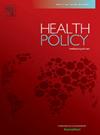放射学工作流程中的大型语言模型:德国医疗保健系统中非视觉任务的生成人工智能的探索性研究。
IF 3.4
3区 医学
Q1 HEALTH CARE SCIENCES & SERVICES
引用次数: 0
摘要
背景:大型语言模型(llm)正因其通过解决工作量增加和人员短缺等挑战来增强放射学工作流程的潜力而受到关注。然而,放射科医生的知识有限,对其实际实施和伦理影响的担忧带来了挑战。目的:本研究调查放射科医生对llm使用的看法,探讨其潜在的好处、挑战以及对工作流程和专业角色的影响。方法:对12位放射学专家进行半结构化访谈,进行探索性质的研究。对数据进行分析,以评估参与者的意识、态度和llm在放射学中的应用。结果:法学硕士被认为是一种很有前途的工具,可以通过简化总结临床病史和生成标准化报告等任务来减少工作量,改善沟通和效率。与会者对法学硕士整合持开放态度,但对其对人际交往、道德标准和责任的影响表示担忧。随着法学硕士的采用,放射科医生的角色预计会随着数据管理和跨专业合作的转变而发展。实现的障碍包括意识有限、监管约束和过时的基础设施。结论:法学硕士的整合受到监管挑战、过时的基础设施和放射科医生意识有限的阻碍。政策制定者应制定明确、实用的法规,以解决责任和道德问题,同时确保遵守隐私标准。对现代化临床基础设施和扩大培训计划的投资对于使放射科医生有效地使用这些工具至关重要。通过解决这些障碍,llm可以提高效率,减少工作量,改善患者护理,同时保留放射科医生在诊断和治疗过程中的核心作用。本文章由计算机程序翻译,如有差异,请以英文原文为准。
Large language models in radiology workflows: An exploratory study of generative AI for non-visual tasks in the German healthcare system
Background
Large language models (LLMs) are gaining attention for their potential to enhance radiology workflows by addressing challenges such as increasing workloads and staff shortages. However, limited knowledge among radiologists and concerns about their practical implementation and ethical implications present challenges.
Objective
This study investigates radiologists' perspectives on the use of LLMs, exploring their potential benefits, challenges, and impact on workflows and professional roles.
Methods
An exploratory, qualitative study was conducted using 12 semi-structured interviews with radiology experts. Data were analyzed to assess participants' awareness, attitudes, and perceived applications of LLMs in radiology.
Results
LLMs were identified as promising tools for reducing workloads by streamlining tasks like summarizing clinical histories and generating standardized reports, improving communication and efficiency. Participants expressed openness to LLM integration but noted concerns about their impact on human interaction, ethical standards, and liability. The role of radiologists is expected to evolve with LLM adoption, with a shift toward data stewardship and interprofessional collaboration. Barriers to implementation included limited awareness, regulatory constraints, and outdated infrastructure.
Conclusions
The integration of LLMs is hindered by regulatory challenges, outdated infrastructure, and limited awareness among radiologists. Policymakers should establish clear, practical regulations to address liability and ethical concerns while ensuring compliance with privacy standards. Investments in modernizing clinical infrastructure and expanding training programs are critical to enable radiologists to effectively use these tools. By addressing these barriers, LLMs can enhance efficiency, reduce workloads, and improve patient care, while preserving the central role of radiologists in diagnostic and therapeutic processes.
求助全文
通过发布文献求助,成功后即可免费获取论文全文。
去求助
来源期刊

Health Policy
医学-卫生保健
CiteScore
6.40
自引率
6.10%
发文量
157
审稿时长
3-8 weeks
期刊介绍:
Health Policy is intended to be a vehicle for the exploration and discussion of health policy and health system issues and is aimed in particular at enhancing communication between health policy and system researchers, legislators, decision-makers and professionals concerned with developing, implementing, and analysing health policy, health systems and health care reforms, primarily in high-income countries outside the U.S.A.
 求助内容:
求助内容: 应助结果提醒方式:
应助结果提醒方式:


